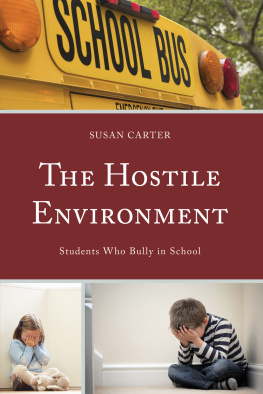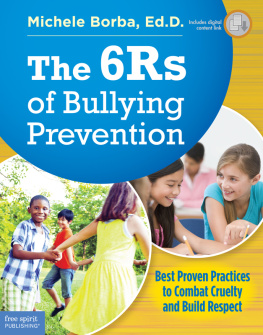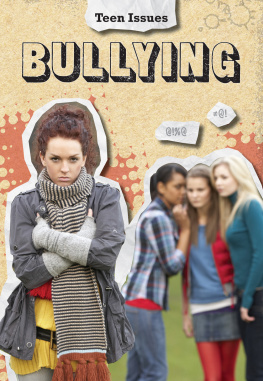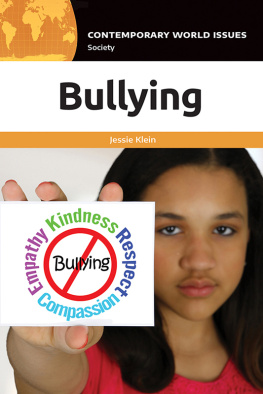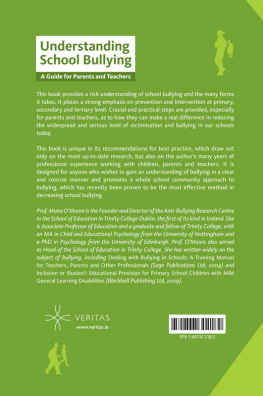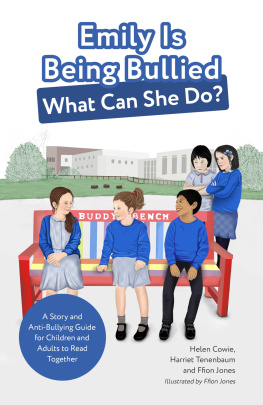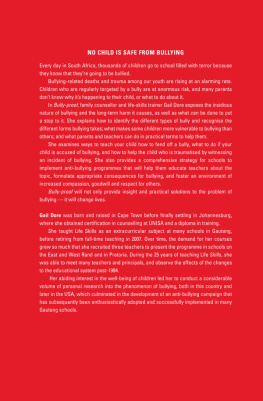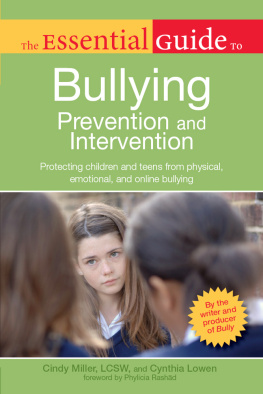Table of Contents
About This Book
Several years ago, the pain of being mistreated visited our home. When our son, Curtis, was in seventh grade, he was bullied and eventually isolated by several students. My wife and I decided to transfer him to another school system. He found acceptance and a sense of belonging at the new middle school. Then at age fifteen, Curtis was in a car accident that changed his life.
My wife and I had to give the surgeons permission to remove two fingers and one-third of his right hand. He had two other fingers repaired and one rebuilt. When he went back to school, many of his classmates encouraged and supported him. But many were cruel to him. Once again, I asked myself, How can kids be so cruel? There was a cry from within me for answers. I wanted to know if I could stop cruelty from developing, and I wanted to stop it after it had already developed.
There was also a cry from within my son, and it was deeper and more intense than mine. The bullying had a tremendous impact on his self-esteem, confidence, and emotional health even into his adult years. At the age of twenty-three, he suffered from depression and anxiety. He developed posttraumatic stress from the car wreck and the persistent peer mistreatment. He also sought the company of the wrong people. He got desperate to escape his pain by taking an illegal drug. He had a heart problem that no one knew about, and the drug killed him.
Now you understand why I am passionate about preventing and stopping bullying and why I am writing this book for you. I understand the pain expressed by children who are mistreated and the heartache their parents experience. I want to stop the pain. I also have witnessed the frustration of professionals who seek to prevent and stop bullying. They have a tremendous need for a step-by-step guide to implementing a program that will prevent and stop bullying.
In response to my sons bullying, I wrote my first book, The Bully Free Classroom. I wrote this book you are holding because I do not want any student to experience what our son did. I especially do not want them to take the path he took. After his death, I wrote several books and developed numerous other materials and resources (bracelets, brochures, posters, and others) that now make up the Bully Free Program. My wife, Linda Beane, and I coauthored one book, Bully Free Bulletin Boards, Posters, and Banners. Thousands of schools in the United States and other countries now use our materials and resources, and Linda and I work full time helping schools implement the Bully Free Program. We have dedicated the rest of our lives to preventing and stopping bullying. Our efforts have expanded into presenting school assembly programs, presenting to parents, training school personnel, and training others who work with young people. Visit our Web site, www.bullyfree.com, for more information.
Bullying can be found in every neighborhood, school system, and school. To prevent and reduce it requires a systematic effort in each school. Ideally, there will be a school-system-wide commitment to preventing and stopping bullying. There must be adult involvement, including parents and others in the community. But this kind of commitment doesnt always exist. I have actually had school superintendents tell me that bullying didnt exist in their school system. Adults denying that bullying exists or ignoring bullying is the worst thing that can happen to children, a school, and a community. When adults harness the energy of school personnel, parents, community representatives, and children, bullying can be prevented and stopped, or at least significantly reduced. I often wonder if we can ever eliminate itconsidering the nature of human beings. However, I am extremely hopeful. Using this book is the first step toward making that a reality.
I hope you find this book informative and helpful.
Allan L. Beane
April 2009
Acknowledgments
I offer my grateful thanks to everyone who has helped by providing advice, information, and comments during the preparation of this book. Special acknowledgment and thanks are due to my wife, Linda Beane, for her proofreading and her desktop publishing knowledge and skills. I deeply appreciate her insight, love, and support during this project. Special thanks are also due to Darlene Gibson for her thorough proofreading of an earlier manuscript. I want to express my sincere gratitude to Kate Bradford and Nana Twumasi at Jossey-Bass for their editorial assistance, knowledge, skills, ideas, encouragement, and support during the preparation of this manuscript.
This book is dedicated to our son, Curtis Allan Beane, who was bullied in seventh grade and high school. It is also dedicated to our daughter, Christy Turner; our son-in-law, Mike; and our grandchildren, Emily Grace Turner, Sarah Gail Turner, Jacob Allan Turner, and Jimmy Andrew Turner. They have been the light in the darkness caused by Curtiss death. We hope this book, and those who use it, will bring light into the darkness of students who are mistreated.
The Author
Allan L. Beane, Ph.D., is an internationally recognized expert, speaker, and author on bullying. He is the president of Bully Free Systems LLC in Murray, Kentucky. He has over thirty-four years of experience in education that includes teaching special education, teaching regular education, serving as vice president of a university, and serving as director of a school safety center. He has served as an expert and consultant in criminal cases and lawsuits involving bullying and has been an expert guest on Fox News and CNNs Nancy Grace Show. He and material from his anti-bullying program have been featured in many national magazines and journals, such as USA Today, USA Weekend, Time for Kids, Newsweek for Teens, School Transportation News, and Parenting magazine. Beanes son was bullied in seventh grade and high school. His sons life inspired him to develop his anti-bullying program, the Bully Free Program, which has been adopted around the United States. His books, The Bully Free Classroom (Free Spirit Publishing) and Protect Your Child from Bullying (Jossey-Bass), are available in several languages. He often gives keynote addresses, speaks to students and parents, and provides training for school personnel and others. For more information, visit his Web site at www.bullyfree.com.
Introduction
Bullying is a form of overt and aggressive behavior that is intentional, hurtful (physically or psychologically, or both), and persistent (repeated). Bullied students are teased, harassed, and assaulted (verbally or physically, or both) by one or more peers and often socially rejected by their peers. In any bullying, there is an imbalance of strength (power). Students should not be made to feel they are alone in coping with their mistreatment. One of the most effective deterrents to bullying is adult authority and supervision. Unfortunately, adults in our schools cannot tackle this problem alone. Efforts to combat bullying must be a collaboration among school personnel, volunteers, students, parents, law enforcement, community agencies and organizations, and others. The Bully Free Program includes such collaboration. Anti-bullying programs should include not only policies and procedures, but also prevention and intervention strategies that are administrative and teacher centered, as well as curriculum.


